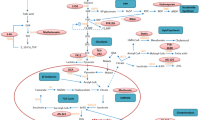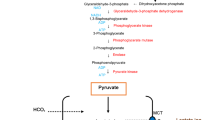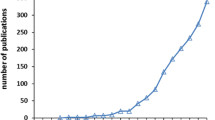Abstract
In the preceding paper (A. Ghosh et al. (2011) Biochemistry (Moscow), 76, 1051–1060), using several comparable tissue materials, it has been convincingly demonstrated that methylglyoxal, a normal metabolite, inhibits mitochondrial complex I of specifically malignant cells. This suggests a distinct alteration of complex I, a highly important enzyme for energy (ATP) production, in malignancy. The present paper shows that as a consequence of this inhibition mitochondrial membrane potential is drastically reduced in sarcoma tissue but not in normal skeletal muscle. This was estimated spectrofluorimetrically using the dye rhodamine 123. As a consequence, cytochrome c was released from the sarcoma mitochondria as evidenced by Western blot analysis. Moreover, on treatment with methylglyoxal membrane potential collapse of sarcoma 180 cells was also indicated by fluorescence-activated cell sorter analysis. Atomic force microscopic study demonstrated gross structural alteration specifically of tumor mitochondria on methylglyoxal treatment. All these studies suggest that methylglyoxal might initiate an apoptotic event in malignant cells.
Similar content being viewed by others
Abbreviations
- AFM:
-
atomic force microscopy
- FACS:
-
fluorescence-activated cell sorter
- JC-1:
-
5,5′,6,6′-tetrachloro-1,1′,3,3′-tetraethyl benzimidazolyl carbocyanine iodide
- 3MC:
-
3-methyl cholanthrene
References
Talukdar, D., Ray, S., Ray, M., and Das, S. (2008) Drug Metab. Drug Interact., 23, 175–210.
Kalapos, M. P. (2008) Drug Metab. Drug Interact., 23, 69–91.
Talukdar, D., Chaudhuri, B. S., Ray, M., and Ray, S. (2009) Biochemistry (Moscow), 74, 1059–1069.
Szent-Györgyi, A. (1979) Ciba Found. Symp., 67, 3–18.
Ghosh, A., Bera, S., Ghosal, S., Ray, S., Basu, A., and Ray, M. (2011) Biochemistry (Moscow), 76, 1051–1060.
Wong, T. W. L., Yu, H. Y., Kong, S. K., Fung, K. P., and Kwok, T. T. (2000) Life Scie., 67, 1111–1118.
El-Mir, M. Y., Nogueira, V., Fontaine, E., Averet, N., Rigoulet, M., and Leverve, X. (2000) J. Biol. Chem., 275, 223–228.
Patra, S., Bera, S., Roy, S. S., Ghoshal, S., Ray, S., Basu, A., Schlattner, U., Wallimann, T., and Ray, M. (2008) FEBS J., 275, 3236–3247.
Moreadith, R. W., and Fiskum, G. (1984) Anal. Biochem., 137, 360–367.
Baracca, A., Sgarbi, G., Solaini, G., and Lenaz, G. (2003) Biochim. Biophys. Acta, 1606, 137–146.
Reers, M., Smiley, S. T., Mottola-Hartshorn, C., Chen, A., Lin, M., and Chen, L. B. (1995) Methods Enzymol., 260, 406–417.
Layton, B. E., Sastry, A. M., Lastoskie, C. M., Philbert, M. A., Miller, T. J., Sullivan, K. A., Feldman, E. L., and Wang, C. W. (2004) BioTechniques, 37, 564–573.
Layne, E. (1957) Methods Enzymol., 3, 447–454.
Du, J., Suzuki, H., Nagase, F., Akhand, A. A., Yokoyama, T., Miyata, T., Kurokawa, K., and Nakashima, I. (2000) J. Cell. Biochem., 77, 333–344.
Inarrea, P., Moini, H., Han, D., Rettorl, D., Aguilo, I., Alava, M. A., Iturralde, M., and Cadenas, E. (2007) Biochem. J., 405, 173–179.
Mancini, M., Anderson, B. O., Caldwell, E., Sedginasab, M., Paty, P. B., and Hochenbery, D. M. (1997) J. Cell. Biol., 138, 449–469.
Pritchard, D. E., Singh, J., Carlisle, D. L., and Patierno, S. R. (2000) Carcinogenesis, 21, 2027–2033.
Speer, O., Morkunaite-Haimi, S., Liobikas, J., Franck, M., Hensbo, L., Linder, M. D., Kinnunen, P. K., Wallimann, T., and Eriksson, O. (2003) J. Biol. Chem., 278, 34757–34763.
Banerjee, T., and Mukhopadhyay, R. (2008) Biochem. Biophys. Res. Commun., 374, 264–268.
Kang, Y., Edwards, L. G., and Thornalley, P. J. (1996) Leuk. Res., 20, 397–405.
Chan, W. H., Wu, H. J., and Hsuuw, Y. D. (2005) Ann. N. Y. Acad. Sci., 1042, 372–378.
Milanesa, D. M., Choudhury, M. S., Mallouh, C., Tazaki, H., and Konno, S. (2000) Eur. Urol., 37, 728–734.
Ly, J. D., Grubb, D. R., and Lawen, A. (2003) Apoptosis, 8, 115–128.
Buttke, T. M., and Sandstrom, P. A. (1994) Immunol. Today, 15, 7–10.
Author information
Authors and Affiliations
Corresponding author
Additional information
Published in Russian in Biokhimiya, 2011, Vol. 76, No. 10, pp. 1428–1436.
Rights and permissions
About this article
Cite this article
Ghosh, A., Bera, S., Ray, S. et al. Methylglyoxal induces mitochondria-dependent apoptosis in sarcoma. Biochemistry Moscow 76, 1164–1171 (2011). https://doi.org/10.1134/S0006297911100105
Received:
Published:
Issue Date:
DOI: https://doi.org/10.1134/S0006297911100105




